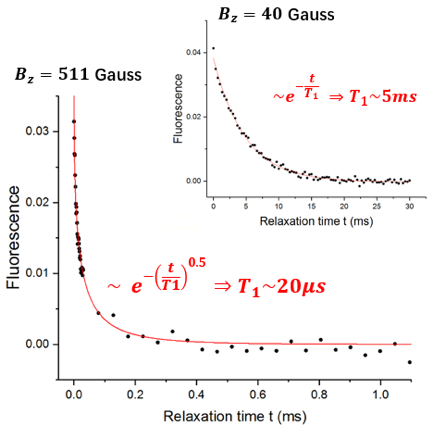NItrogen-Vacancy Spin Defects in Diamond
At the nanoscale, isolated spins can be exceedingly stable and precisely controlled. This holds the promise for their use as quantum bits, the basic building block of a quantum computer. Their natural stability also renders them sensitive magnetic, electric, and thermal probes. Recent experimental advances have enabled the control and manipulation of individual quantum mechanical spins --- Nitrogen-Vacancy (NV) defects --- in diamond. In each defect, a nitrogen atom and an adjacent vacancy substitute for two carbon atoms in the diamond lattice. The NV harbors a spin triplet electronic ground state that can be polarized, manipulated and optically detected. Our group is interested in studying the magnetic properties of layered two dimensional materials and in pressure-driven phase transitions using both single and ensemble NV magnetometry.
RT1: Nanoscale Magnetometry of 2D materials
NV spectroscopy of external fields
Excitation of shallow NV centers
In conjunction with our colleagues in the Ultrafast Nano-Optics Group, we use shallow NV centers to probe exciton spin relaxation and coherence dynamics in van der Waals heterostructures. Recent measurements on spin relaxation and coherence times using optical Kerr spectroscopy have demonstrated extremely long electron spin lifetimes. Our setup consists of back-gated monolayer transition metal dichalcogenides exfoliated on a diamond substrate with shallow NVs implanted within a few nanometers of the diamond surface.
Since the NV electronic spin couples directly to both DC and AC magnetic fields, the energy splitting between the NV's Zeeman sub-levels behave as a sensitive probe of any spin polarization of the TMD excitons. In particular, we plan to use wide-field imaging to directly map out the vector magnetic field generated by circularly polarized excitation of the TMD. This is enabled by the fact that excitons in the K and K' valleys selectively couple to left and right circularly polarized light. In combination with strong spin-orbit coupling in the valence band, this enables one to excite both spin and valley polarized excitons by using a combination of polarization and frequency selection. The ultimate sensitivity of our approach is determined by a combination of spin coherence time and spin projection noise. We will utilize Ramsey spectroscopy, which maps the magnetic field generated by the excitons into a relative phase difference accumulated by the NV's electronic spin states. By alternating the TMD excitation between left and right circular polarization, we can perform spin-echo spectroscopy, which significantly enhances the NV sensitivity.
RT2: nanoscale sensing At high pressures
Since their introduction, diamond anvil cells (DACs) have become the most versatile approach to generating sustained high pressures inside the laboratory. By compressing a thin sample between two opposing diamonds, pressures over hundreds of gigapascal can be achieved. These systems provide a useful platform for realizing pressure-driven quantum phase transitions that can elucidate our understanding of quantum materials. However, owing to the sharp pressure gradient between the micron-scale sample chamber and its ambient surroundings in the laboratory, localized measurements of stress gradients, magnetic fields, or temperature are challenging. We propose the development of NV centers as a tool for pressure calibration and nanoscale sensing in DAC systems.
By preparing a diamond anvil with an ensemble of NV centers, one can study spatially resolved tensorial stress gradients inside the anvil over a millimeter scale. While these gradients have been simulated extensively, a complete experimental measurement has remained elusive. The systematic study of these stress gradients may inform the design of novel anvil geometries that are capable of sustaining new pressure regimes more reliably.
Using alternative but complementary sensing modalities, one can perform magnetometry and thermometry using a thin layer of NV centers near a diamond anvil cell sample chamber to study pressure-induced magnetic phase transitions. We are using this tool to construct spatially resolved pressure-temperature phase diagrams of skrymion materials, for which pressure has already proved to be an interesting order parameter for extending the thermodynamic stability region of the skyrmion phase. The combination of nanoscale spatial resolution and simultaneous sensing of stress, magnetism, and temperature afforded by the NV center provides a rich and unexplored phase space for the study of quantum phases of matter.
Diamond anvil cell schematic
Confocal Imaging of NVs in a Diamond Anvil Cell
Scanning confocal image of diamond anvil. The fluorescence in the center (white) is from ruby microspheres in the sample chamber to calibrate pressure. The remaining fluorescence in the image is from NV centers in the anvil.
RT3: Quantum dynamics of coupled spins
NV spin relaxation at different external magnetic field. At 40 Gauss, NV is off-resonant with nearby P1 centers, its spin relaxation is a single exponential decay with T1~5 ms, which is limited by coupling to phonons in diamond. However, at 511 Gauss, NV center is resonant with nearby P1 centers, resulting in a 100-fold increase in spin relaxation rate (T1~20 us), which fits to a stretch exponential due to strong magnetic dipole-dipole interaction.
Recent experimental progress has enabled the coherent control and optical readout of nitrogen-vacancy (NV) defects in diamond at room temperature. This system provides us a promising platform to study spin dynamics. By tuning an external magnetic field, one can vary the coupling strength between individual NV centers and nearby nitrogen defects (P1 centers), enabling the direct extraction of the P1 density. In type Ib synthetic diamond, P1 center density can be as large as ~150 ppm, resulting a NV-P1 average spacing ~1.8 nm. At this distance, the magnetic dipole-dipole interaction strength between NV and P1 electronic spins and P1 is ~ 8 MHz. By leveraging the NV center as an entropy sink, we initialize the spin state of nearby P1 centers and observe the resulting quantum dynamics.
By shining different duration green laser to our NV center and using it as an entropy sink, we successfully initialize a polarized spin core of nearby P1 spins with different radius.








